Stanford researchers discovered that verteporfin, a drug traditionally used to prevent vision loss, can prevent scar formation in mice — a significant finding that could have implications on scar formation in humans.
The research was led by Michael Longaker, professor of plastic and reconstructive surgery, and Geoffrey Gurtner, vice chairman of Stanford’s surgery for innovation center. It was published in Science in late April.
Scars are not only a cosmetic issue, as they can cause severe impairment of skin and joints. Scar tissue can also lock limbs in place, which is particularly common in patients in low-resource settings without access to medical treatment. In the United States, it is estimated that 45% of deaths annually can be attributed to scarring of the skin and vital organs.
Longaker and Gurtner set out to study a pathway that leads to scar formation in mice and discovered that a pre-existing drug called verteporfin was able to block it. The drug is currently used as an intravenous injection to treat macular degeneration, a condition that causes vision loss. By adding the drug to a gel and placing it on skin wounds, the researchers found that it could prevent scars from forming in mice with skin incisions.
They are now testing the medication in pigs, which have skin that is more similar to humans, and have received an NIH grant to run a clinical trial with human burn victims over the next few years.
Both researchers’ interest in scarring began years prior.
Longaker has been interested in the subject since he was a surgical intern decades ago. At the time, he was working under Michael Harrison, a University of California, San Francisco surgeon who pioneered surgery on fetuses. Harrison had found something peculiar: unlike human beings, fetuses did not develop scars if operated on prior to the third trimester.
“Without changing our DNA, we go from scar-free to scarring during our time in the womb — but how?” Longaker said. “This single question changed my career. How can we get people outside of the uterus to heal in the same ways that they did when they were fetuses?”
Gurtner’s inspiration came during his rotation in the burns unit at the Boston Shriners Children’s Hospital. Many of his patients had full-body burns and routinely underwent anywhere from 60 to 70 surgeries to correct their skin. Even after the surgeries, many were still left with disfiguring scars.
“These children would survive these catastrophic burn injuries, but their whole lives would be completely devastated because they looked like burn victims,” Gurtner said. “These injuries were only skin-deep, but they changed these kids’ lives forever.”
Scars often prevented his patients from finding jobs as they grew up, Gurtner explained. Scar tissue would also form around their joints, which prevented them from moving their arms and legs and constrained their mouths and eyes. Once the scars formed, surgeons could cut the scar tissue away, but it would likely form again within the next few months.
The researchers hope that one day, their findings can help patients locally and across the globe, especially since the drug has been on the market for many years as an intravenous injection to prevent macular degeneration. Gurtner, who has spent time abroad treating children with kerosene burns, says he hopes this treatment can help children in low-resource settings who often lack access to burn centers.
“The burns completely disabled the children I met in these communities,” said Gurtner. “They prevented these kids from ever working, from creating and supporting their own families down the road.”
Kellen Chen, postdoctoral fellow in plastic and reconstructive surgery, said these findings may also have implications beyond the healing of skin wounds.
“It could have exciting implications to prevent scarring in a variety of organ systems, such as the liver,” Chen said. He said more research will need to be done to see if organs like the heart, which require mechanical stress to function, could benefit from this type of treatment as well.
